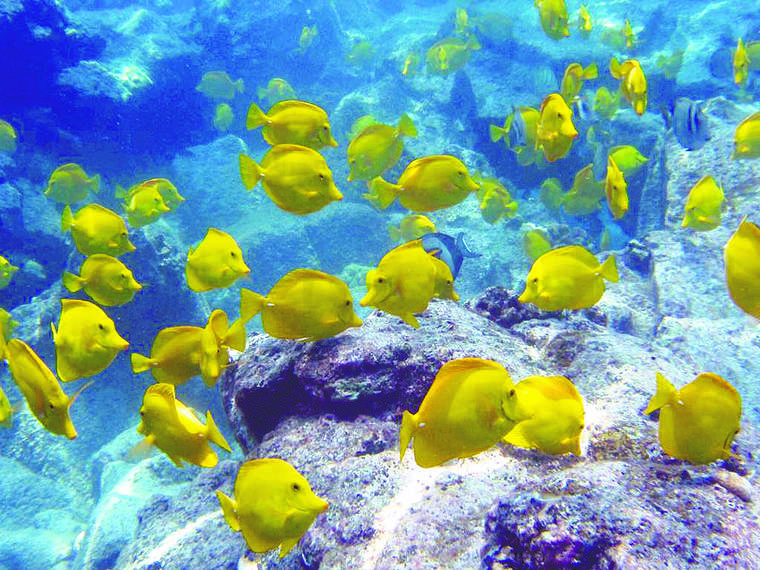Aquarium trade proposes reopening West Hawaii fishery
HONOLULU — The coastal waters off West Hawaii, closed to aquarium fishing for two years, would reopen to 14 commercial fishermen under a proposal described in environmental documents submitted to the state.
But critics said the industry’s draft environmental impact statement is flawed because it imposes almost no limits on the number of fish commercial fishermen can take.
“To propose no limits and then to pretend it does not impact abundance is totally crazy,” said Rene Umberger, executive director of the Maui nonprofit For the Fishes.
The state Department of Land and Natural Resources is accepting comments on the draft document written by the Pet Industry Joint Advisory Council through Jan. 7.
The document is aimed at bringing the aquarium trade into compliance with the Hawaii Environmental Policy Act after the state Supreme Court in 2017 held that collection without environmental review violates the act.
DLNR was later ordered by the Circuit Court to stop issuing aquarium collection permits until the environmental effects of aquarium collection are fully explored through the environmental process.
The aquarium trade completed environmental assessments for two islands, but DLNR rejected them as insufficient and told the industry to do a more extensive impact study.
Under the latest environmental document, the preferred alternative will allow 14 commercial fishermen the right to take aquarium fish in nearshore areas from Ka’u to North Kohala. The only limit would be on the taking of Achilles tang, cutting in half the daily bag limit to five from 10.
According to the draft study, the issuance of the 14 permits would cause no significant impacts. An analysis of islandwide National Oceanic and Atmospheric Administration data, it said, indicates that the annual collection of 38 of the 40 collectible reef fish would be less than 1% of their Hawaii island populations, and the collection of the remaining two species would be less than 2%.
This level of collection, the study said, is below what is considered for a sustainable reef fish harvest based on available research.
The draft document says two studies have concluded that the aquarium fishery has no significant impact on coral reef ecosystems and that the herbivores typically collected by the fishery are the least effective for cropping algae. One study found no increases in the abundance of algae where the number of herbivores was reduced by aquarium collecting.
Finally, because the fishery has no significant impact on the species as a result of the preferred alternative, there will be no significant impact on cultural resources.
Critics of the draft report said the DLNR should reject it.
Inga Gibson, policy director of Pono Advocacy, said the document is based on the premise that aquarium collecting doesn’t affect fish populations on the reefs where the trade operates.
“Nothing could be further from the truth,” she said.
Earthjustice attorney Kylie Wager Cruz said the unrestricted level of collecting proposed in the environmental document is unsustainable.
The document, she said, skews the data by comparing catch numbers to estimates for fish populations on the entire island, which minimizes the impacts to local reef ecosystems.
“There is nothing stopping them from going to their favorite bay and taking every single fish,” Umberger said.
The draft study also dismisses testimony from dozens of Native Hawaiian cultural practitioners, Gibson said, and instead concludes that collection for the aquarium industry has no cultural impact as long as the fish populations are not significantly reduced.
Despite a surge in fish abundance since West Hawaii aquarium collecting was stopped in 2018, populations in those areas are still 60% lower than those found in long-term protected areas, indicating an ongoing and severe impact by the trade, according to Earthjustice.
“Hawaii needs its reef fish now more than ever before,” Maxx Phillips, Hawaii director with the Center for Biological Diversity, said in a news release. “Hawaii is expected to lose 70 percent of our coral reefs in the next couple of decades, so we don’t have time for aquarium industry-sponsored justifications for raiding the reefs. Our reefs depend upon the restoration of that balance and the return to natural abundance.”


